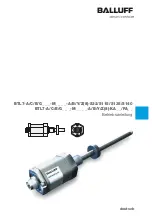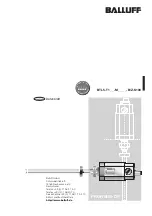
NV5LT/NV3.5LT TROUBLESHOOTING MANUAL
RESPONDING TO ALARMS
VERSION 3.3 2016-03-10
PAGE 4.1.23
Module #: High Reject
Power (High Rej)
Power Amplifier (red) This alarm occurs if the associated module’s reject load power exceeds
400 W. This may be the result of PA failures. Check for associated alarms
and troubleshoot accordingly. This alarm may be accompanied by a Reject
Foldback alarm, which means the transmitter power will be reduced to
protect the reject load.
Module #: High RF
Drive Power (RF Drv
High)
Power Amplifier (red) This alarm is indication only and occurs if the input RF drive (exciter power)
is greater than 45 W. Check the exciter power setpoint to make sure it is
correct for the transmitter.
Module #: High
Temperature (High
Temp)
Power Amplifier (red) This alarm occurs if the associated module’s heatsink temperature exceeds
85°C (185°F). This alarm is most likely caused by excessive ambient
temperature, a module fan failure or blockage, or excessive power amplifier
dissipation. This alarm will clear when the module’s heatsink temperature
decreases to 75°C (167°F).
Module #: Low RF
Drive Power (RF Drv
Low)
-
This alarm occurs if the input RF drive (exciter power) is less than 10 W and
the transmitter has not intentionally reduced it to that level. This may be the
result of an exciter fault, excessive load variation on the active exciter
output, or defective components on the RF drive splitter/changeover
assembly.
Module #: Missing
Power Amplifier (red) This alarm occurs if the RF power module is removed. If the associated RF
power module is present, and the alarm still occurs, try reseating the RF
power module. If the alarm persists, suspect a fault with circuitry on the
module control/interface PWB (A3). See also Rack #: Module Extraction
Shutback alarm.
Module #: No PAs
Operational (No PAs
Op)
Power Amplifier (red) This alarm occurs when all of the power amplifiers in the associated module
are inactive due to external conditions such as ac power loss, removal of
power supplies, or faults in the power supplies or power amplifiers. Check
for associated alarms and troubleshoot accordingly.
Module #: PA Current
Imbalance (PA Curr
Imb)
Output Network
(amber)
Power Amplifier (red)
This alarm occurs when the maximum PA current on one side of the power
module combiner exceeds 3.5 times the maximum PA current on the other
side of the combiner. This will latch off the module, since it indicates a
possible fault in the transmitter combiner or output network. If more than
one module has this alarm, the transmitter will shut down with a Combiner
Match alarm.
Module #: PA Volts A
(or B) Fail [PA V A (or
B) Fail]
Power Supply (red)
This alarm indicates the PA voltage from the power supply does not match
the requested setpoint. This is likely caused by a power supply failure. Check
the associated power supply module (A or B).
Device and
Alarm Name
(AUI, UI)
Front Panel LED
(color)
Description and Troubleshooting Action
Summary of Contents for NV3.5LT
Page 2: ......
Page 4: ......
Page 8: ...NV5LT NV3 5LT TROUBLESHOOTING MANUAL PAGE 4 VIII VERSION 3 3 2016 03 10 ...
Page 294: ...VERSION 3 3 2016 03 10 SD 32 Figure SD 32 NAFP109B Output Power Probe and Sample PWBs ...
Page 307: ...VERSION 3 3 2016 03 10 MD 8 Figure MD 8 NAPA31C Power Amplifier PWB Q1 ...
Page 322: ...NV5LT NV3 5LT TROUBLESHOOTING MANUAL LIST OF TERMS PAGE 4 6 2 VERSION 3 3 2016 03 10 ...
Page 323: ......
















































